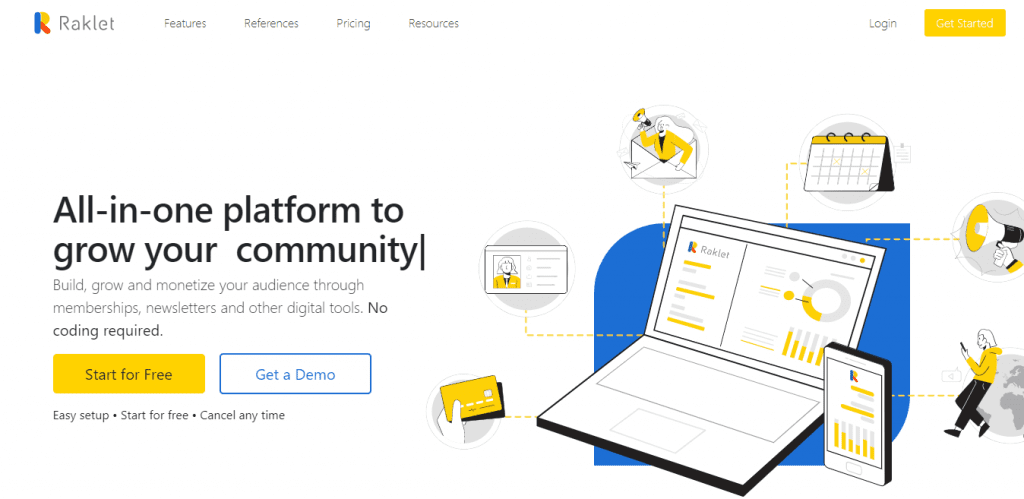Community management has become more and more important with the increasing use of social media and the rate of forming online communities. Having a strong brand presence and awareness involves high engagement and loyalty rates from your community. Keep on reading to learn more about community management, some best practices, and how to improve the process with our all-in-one solution, Raklet!
What is community management?
Community management is the whole process of building a community of customers or members for your brand or organization and keeping them engaged with different interactions in the long run. A community management strategy includes all the steps leading to a perfectly engaged community. There are several ways to interact and engage with your audience to increase connection, growth, and loyalty. However, one of the most important interaction types is social media nowadays.
Community management brings a lot of benefits to your organization or business. Some of these benefits include:
- Getting real direct feedback from customers/members,
- Increasing conversion rates,
- Increasing brand and product awareness,
- Learning about customer needs in-depth,
- Providing more value to your customers beyond the product or service,
- And many more!

What is the purpose of a community manager?
A community manager is responsible for executing the community management strategy and keeping communications both internally and externally. Community managers usually work with a lot of different departments including PR, Marketing, and Communications. Their tasks may include:
- Providing community support,
- Monitoring feedback,
- Distributing content,
- Creating digital engagement,
- Planning social media and communication strategies,
- Building brand presence and awareness.
The Main Difference? Community Management vs. Social Media Management
Customer support, reputation management, and sales representatives would all be in charge of community management. In order to successfully respond to urgent issues, the community manager has to grasp how social platforms operate as well as how to monitor and actively listen on each social media site.
On the other hand, a social media manager’s duties and obligations would include social media management. This person actively develops the social content strategy and posts material on the allotted social media channels. They must fully comprehend how each social media platform functions as well as how to use social analytics to locate a brand’s audience.
6 Reasons Why Community Management is Important
Relevant content
Your brand is not impervious to change since the internet is a constantly changing environment. You need a strategy to handle the continual bombardment of information being fed to your audience. By contributing your viewpoint to a hot topic discourse, you may achieve this. This positions your brand in the thick of the activity, solidifying your position as an authority that can offer useful insights rather than acting as a bystander. This establishes you as a helpful resource and a brand that is current since it demonstrates that you are keeping up with changing trends.
More intimate communication
Automated replies won’t likely have much of an impact on your audience, just as they wouldn’t have much of an impact on you. In order to come across as human, authentic, and genuine, emotional language is crucial. Ask questions, see how your audience behaves, and get interested in their hobbies. Who do they follow and what do they do online? Openness and genuine communication with your audience are key components of humanizing your brand. The proper people will start to notice if you sound like a human instead of a business robot since personal, authentic relationships last longer online. A one-time purchase is transformed into a brand-loyal customer via authenticity.
Increased brand credibility and reputation
The fake news accounts that troll internet forums are becoming all too familiar to social users. Your brand gains credibility through facts, wisdom, and counsel, and the more discussions you participate in, the more important your opinion becomes. Acting like you’re already an authority in your subject and using a consultative style are two ways to get noticed for your knowledge. Why is this action crucial to your social strategy? Scrollers are loyal to the brands they recognize, thus building your brand’s reputation makes it easier for customers to use it as a reference.
Improved customer support
Improved customer service and more meaningful connections with them are two significant advantages of establishing an online community. The possibility of peer-to-peer help can also reduce your own support expenses since users will be able to discover answers to many problems by just asking the larger community, which will benefit both your customers and your business.
Only a well-run community will allow for this. Posts, comments, and inquiries will be missed if your community management is subpar, which will hurt your brand. Even worse, if a customer writes a complaint and it is not addressed, they may conclude that your company doesn’t give a damn about what they have to say.
Accessible data
Every operation in your company depends on data, which is why so many platforms are restricting your access to it (or charging more). Online communities have several advantages over social networking platforms, like data ownership, which allows businesses to better target their consumers by understanding what makes them tick.
Numerous data sources will be available from a well-managed community that may be used to enhance marketing, sales, customer service, product development, and other areas. On the other hand, because of a smaller, less active user base, a badly managed community will provide you with fewer data points to evaluate. Therefore, you must focus even more on community management if you want to get the most out of your data ownership.
Increased member acquisition rates
The price of acquiring customers is going up. People are incredibly busy and have short attention spans. Therefore, it’s becoming more difficult to capture their attention and stand out from the competition utilizing conventional marketing strategies. This implies that retaining your present consumers is becoming increasingly important to the expansion of your business. Business success depends on maximizing lifetime value, which is why more marketers are increasingly interested in what happens after a purchase (product use, customer support, upselling, advocacy, and so on).

5 types of community management strategies
Create a social media group.
Creating a social media platform is a powerful method to expand a company’s community and draw in new customers. Users of several social media platforms have the option to create groups, which may help businesses connect with individuals who have similar interests, conduct events, talk about pressing issues, and keep consumers informed of business news. To pick the ideal alternative for your organization, consider the demographics of your target audience.
Decide who your audience is.
Determine your audience on that platform once you’ve created a social media group or platform. You will be able to see the kinds of material your target audience engages with on the particular platform, what they enjoy and anticipate from companies that are similar to yours that they already follow, and who they are currently engaging with by doing this.
You may start planning how you’re going to customize the content your company produces for your target audience and your preferred platform thanks to the research and information you’ve gathered.
Examine both direct and indirect feedback.
Building a community gives a brand the chance to get honest input from customers on how well it’s doing from their point of view. Customer feedback frequently includes thoughts on goods and services. Reviewing direct consumer feedback may assist a business in building its reputation, identifying major customer issues, and giving prospective customers comprehensive information about company rules.
Asking for this input and being receptive to recommendations also demonstrates to your audience that you value their thoughts and opinions, which can help you increase brand advocacy and loyalty as well as foster fruitful community involvement.
Set community goals.
Setting both realistic and ambitious goals is essential while trying to accomplish your different goals and determine your success, just like it is with most things in business. However, this work could appear challenging if you’re creating a totally new plan or if you’ve never set goals like the ones you must for your social media community management approach. Once you’ve decided how you’ll gauge your progress, consider doing a few tests to get things going.
Create useful online content
To provide customers with value in addition to goods and services, think about posting interesting material online. By generating new leads via content distribution channels and recommendations, digital content may boost a company’s income. Quality digital material frequently includes blog articles, video content, live feeds and online events. You may utilize social listening to discover what type of material your clients may love. To make sure your digital material is consistent and of excellent quality, think about employing a content writer, video producer, or other digital content professional. You can build more client trust by producing interesting content for your audience.
What are some community management examples?
There are endless ways to manage your community and interact with them! Let’s explore some creative community management examples from brands that use social media effectively:
1- Netflix
Netflix has its persona on social media accounts and keeps the entertainment responsibility going across different platforms. From announcements of new shows and films to celebrations of anniversaries, Netflix finds an excuse to include popular jokes and trends in its social media posts. Keeping a sincere and up-to-date language, Netflix certainly demonstrates a dynamic example of community management!
2- Sephora
Another important example of effective community engagement on social media is answering questions from the community in a sincere and friendly manner. The customers feel that they are noticed, their ideas and feedback are heard, and the brand actually works towards better community engagement. Sephora serves as a great example of customer support and direct feedback on social media platforms!

3- Bissell
One of the effective ways for community engagement on social platforms is to ask for your audience’s contribution! Especially on popular and engaging topics such as pets, everyone is eager to have their input and make their voices heard! Driving away from their main area of business, which is vacuums, in this case, Bissell manages to win in the community engagement field!

Benefits of using online community management software
Better community engagement
Users that receive benefits for learning more about your goods and services have a deeper bond with your company. Some could become brand evangelists, spreading the word and sharing their delight with you about their experiences.
Lower costs
As community members exchange information and respond to one another’s queries, you’ll notice a reduction in phone calls for customer assistance when using online community management.
Improved customer experience
Customers’ experiences are enhanced when they find answers to their problems and interact with peers for reliable advice and recommendations. Customers not only receive greater use out of your goods and services, but they also develop relationships with people who can help them in the future when they have questions relating to them.
Boosted SEO
Keywords are frequently used in natural conversation in user-generated material in online communities. Long tail keywords are used to develop content by customers discussing your brand and its goods. Your website appears higher for these keywords in organic search engine results as a consequence.
How can community management be improved?
Depending on the goals and vision of your organization, community management strategies are pretty customizable. You can pick and choose from the different platforms, tools, and plans to achieve your goals regarding your community. Let’s explore some of the general ways to improve:
1- Connect regularly with your community
While creating your strategy, make sure you include regular connections with your community. This can come in the form of scheduling regular social media posts, planning monthly events, checking feedback frequently, or sending weekly personalized newsletters. You should keep them engaged and remind your brand’s presence on a non-disturbing regular basis.
2- Explore new ways to engage
With the ever-changing digital era we are in, you should keep up with the face pace and latest trends! Exploring new social media platforms, popular digital trends, and memes just like Netflix does are all crucial. Who knows maybe the new mobile app will be the right platform to engage with your community event further!

3- Use metrics and analytics
Whichever platform or strategy you choose for community management, you can continually improve by making use of the right metrics! You should analyze your strategy’s performance, customer engagement, click-through rates, and other relevant metrics to see your progress. Always being up-to-date with data and analytics is crucial in the digital era to keep up with regular improvements!
4- Work with community management software
In order to get professional help to cover all your needs, you can consider working with community management software. Here, we recommend Raklet, an all-in-one software with over 4000 integrations and various tools to support your community strategies. You can customize all the features according to your needs, and add monetization opportunities with different integrations such as Stripe. Your community can have its own social network and customers can engage with member profiles and private messages. Raklet offers various features, from sending customized notifications to generating reports and analytics tools!

Now, it’s your turn!
Now that you know more about community management, some best practices, and ways to improve; it is time to implement these into your management system! If you consider working with Raklet to ease the process, you can check out what Raklet offers. In order to learn more and ask any questions, you can book a free demo with us to have one-to-one calls!







